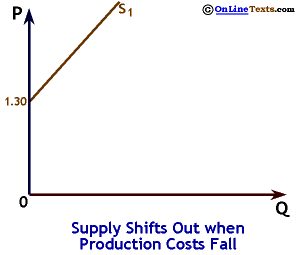
We learned earlier that the supply curve is upward sloping due to rising opportunity costs. Higher prices are required to meet the added costs of increasing output. When there is a change in the underlying cost of production, the supply curve shifts, representing an entirely new supply relationship.
Consider a small business that sells grilled tempeh sandwiches. Suppose the cost of tempeh used in each sandwich falls from US$1.25 to 25 cents ($0.25), lowering the cost of making a tempeh sandwich by a full dollar. If all other costs remained the same, the business can now sell its sandwiches for $1 less without reducing profit. This would mean that their supply curve has shifted from S1 out to S2. The vertical distance between the two curves is equal to this $1 reduction in production costs. We can see this because supply curve S1 intersects the vertical axis at $1.30, S2 intersects at 30 cents. When tempeh sandwiches can be sold for $1.50, only 5 per day are supplied on S1 before the drop in costs, but 24 per day are supplied on S2 after tempeh becomes so much cheaper. When sandwiches sell for $2.00 the supply increases from 20 on S1 to 34 on S2.

